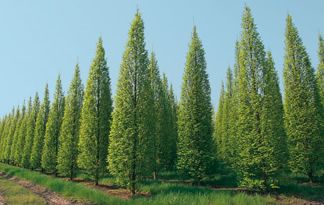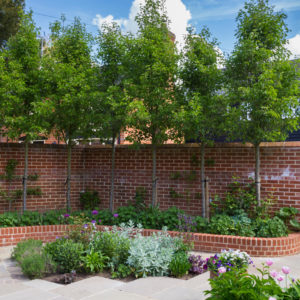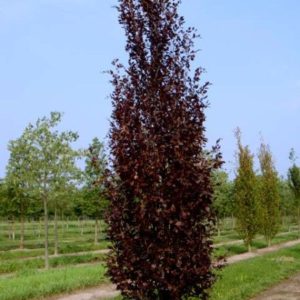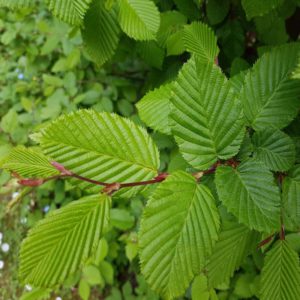Carpinus betulus Fastigiata / Upright Hornbeam
Price range: €180.00 through €750.00
Frequently Bought Together



Description
Quick Facts
- Common Name: Pyramidal Hornbeam, Upright Hornbeam
- Botanical Name: Carpinus betulus ‘Fastigiata’
- Plant Type: Deciduous tree
- Mature Height: 12-15m
- Mature Spread: 4-6m
- Flowering Period: April to May
- Flower Colour: Yellow-green catkins
- Foliage: Fresh green leaves turning golden-yellow in autumn
- Hardiness: RHS H7 (very hardy)
- Soil Requirements: Moist, well-drained, tolerates most soil types
- Aspect: Full sun to partial shade
- Maintenance: Low
Description
Experience the architectural elegance of Carpinus betulus ‘Fastigiata’, the magnificent Pyramidal Hornbeam that brings stately vertical presence and refined beauty to Irish gardens with its distinctive columnar form. This exceptional cultivar offers all the virtues of the beloved common hornbeam in a space-saving upright silhouette, creating living columns that add dramatic height and formal structure without overwhelming smaller gardens, making it the perfect choice for contemporary and traditional landscapes alike.
Throughout the seasons, this captivating tree displays its distinctive narrow, conical form adorned with the characteristic pleated leaves of fresh bright green that create a fine-textured appearance. In spring, elegant yellow-green catkins dangle gracefully from the upright branches, whilst autumn brings a spectacular transformation as the foliage turns warm shades of golden-yellow and amber. The unique quality of retaining dried russet leaves throughout winter provides continued interest and structure during the dormant months, whilst the attractive fluted grey bark adds textural beauty year-round.
Named for its fastigiate (upright, columnar) growth habit, this outstanding cultivar represents one of the finest architectural trees for formal gardens and restricted spaces. Exceptionally hardy and adaptable, ‘Fastigiata’ thrives in Irish conditions, tolerating heavy clay soils, exposed sites, and urban pollution whilst maintaining its elegant upright form with minimal intervention. The naturally columnar habit broadens slightly with age, creating a graceful flame-shaped silhouette.
Create stunning formal compositions by planting in matching pairs flanking gateways and entrances for classical symmetry, or arrange in rows for elegant avenues and allées that bring grandeur to driveways and pathways. Magnificent as specimen trees in lawns, in mixed borders where vertical accent is needed, or in contemporary gardens where architectural form is paramount. Underplant with spring bulbs, low-growing perennials, and ornamental grasses where this stately presence will bring timeless structure, seasonal drama, and sophisticated beauty to your Irish garden sanctuary.
Caragh Garden Notebook
Planting: Space trees 4-6m apart for avenue planting, or allow 8-10m for specimen placement. Plant bare-root trees from November to March, or container-grown specimens year-round. Dig holes twice the width of the root ball and incorporate organic matter. Plant at the same depth as the nursery soil mark, ensuring the root flare is visible. Stake for the first 2-3 years. Water thoroughly and mulch around the base.
Soil Preparation: Thrives in a wide range of soil types with pH 5.5-8.0, from heavy clay to light loam. Prefers moist, well-drained conditions but tolerates both damp sites and periodic drought once established. One of the most adaptable trees for challenging soils. Incorporate organic matter to improve soil structure and fertility. Avoid only extremely waterlogged or very dry, shallow soils.
Container Growing: Young specimens suitable for large containers (minimum 80cm diameter) using soil-based compost for 3-5 years. Water regularly during growing season, reducing in winter but never allowing to dry out completely. Feed in spring with slow-release balanced fertiliser. Best planted out into the ground for long-term health and to achieve full potential.
Seasonal Care: Requires minimal pruning due to naturally columnar habit. Simply remove any dead, damaged, or wayward branches in late winter to maintain form. Remove any shoots emerging from the base promptly. Apply slow-release balanced fertiliser in early spring for young trees. Mulch annually with organic matter to retain moisture and suppress weeds. Water during prolonged dry spells for the first 2-3 years until well established.
Propagation: Propagate by grafting onto Carpinus betulus rootstock in late winter (specialist technique). Seed-grown plants will not maintain the fastigiate form. Cuttings are difficult and unreliable. Most gardeners prefer to purchase nursery-grown grafted specimens for guaranteed columnar habit and quality.







